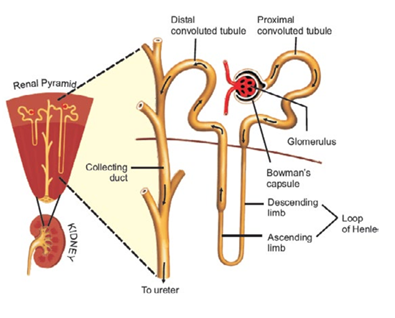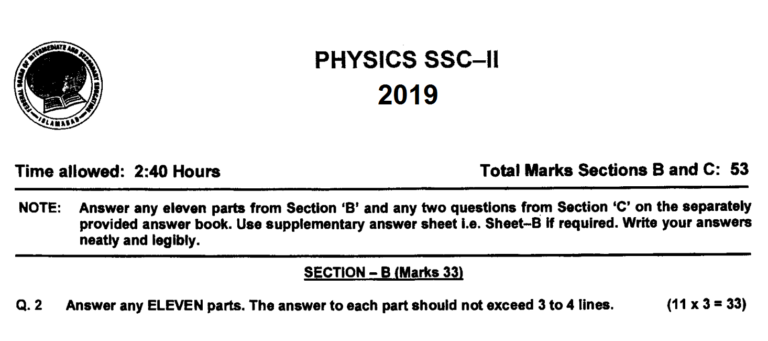Biology 10 Solved Paper 2019
Class 10 Biology Solved Past Paper 2019
Biology 10 Solved Paper 2019 of FBISE is available on this page. We are working on more papers. Please support us by giving feedback.
Section B
Q2.
(i) Give a comparison between the Inspired and the Expired air.
Ans. Comparison between the inspired and expired air is given below:
| Feature | Inspired Air | Expired Air |
| Amount of oxygen | 21% | 16% |
| Amount of carbon dioxide | 0.04% | 4% |
| Amount of nitrogen | 79% | 79% |
| Amount of water vapours | Variable | Saturated |
| Amount of dust particles | Variable | Almost none |
| Temperature | Variable | Almost equal to body temperature |
(ii) Define Xerophytes. Briefly write about their osmotic adjustments.
Ans. Xerophytes
Xerophytes live in dry environments. They possess a thick, waxy cuticle over their epidermis to reduce water loss from internal tissues. They have fewer stomata to reduce the rate of transpiration. Such plants have deep roots to absorb maximum water from the soil.
Some xerophytes have special parenchyma cells in stems or roots in which they store large quantities of water. This makes their stems or roots wet and juicy, called succulent organs. Cacti (Singular Cactus) is a common example of such plants.
(iii) Name the parts of Hind Brain. Also write their location and one function of each.
Ans. Hindbrain
It consists of three major parts.
(i) Medulla oblongata: It lies on the top of the spinal cord. It controls breathing, heart rate, and blood pressure. It also controls many reflexes such as vomiting, coughing, sneezing, etc. Information that passes between the spinal cord and the rest of the brain pass through the medulla.
(ii) Cerebellum: It is behind the medulla. It coordinates muscle movements.
(iii) Pons: It is present on top of the medulla. It assists the medulla in controlling breathing. It also serves as a connection between the cerebellum and spinal cord.
(iv) Briefly explain Movable Joints.
Ans. Moveable joints:
They allow a variety of movements e.g. shoulder joint, hip joint, elbow joint, knee joint, etc. There are many types of moveable joints in the body. The main types are hinge joints and ball-and-socket joints. Hinge joints move back and forth like the hinge on a door and allow movements in one plane only. The knee and elbow are hinge joints.
(v) Name and define three types of Arthritis.
Ans.
1. Osteo-arthritis: It is due to degeneration in the cartilage present at joints or due to decreased lubricant production at joints. In this arthritis, the fusion of the bones at the joint may occur and joints may become totally immovable.
2. Rheumatoid arthritis: It involves the inflammation of the membranes at joints. Its symptoms include fatigue, low-grade fever, pain, and stiffness in joints.
3. Gout: It is characterized by the accumulation of uric acid crystals in moveable joints. It generally attacks the toe joints.
(vi) What do you know about Corms and Bulb?
Ans.
Corms are short and swollen underground stems containing stored food. Buds are present at the top of the corm. From a bud, the shoot grows and forms a new plant. Dasheen and garlic reproduce by corms.
Bulbs are short underground stems surrounded by thick, fleshy leaves that contain stored food. Adventitious roots emerge under the base of the bulb while shoots emerge from the top of the base. Tulips, onions, and lilies reproduce by bulbs.
(vii) Write a short note on third whorl of a Flower.
Ans.
Third whorl of a Flower
Third whorl i.e. androecium is the male reproductive part of a flower. Its units are called stamens. Each stamen has a thread-like filament at the free end of which anther is attached. Anther has pollen-sacs in which haploid microspores (pollen grains) are produced through meiosis.
Each microspore germinates into the male gametophyte generation. During it, the nucleus of the microspore undergoes mitosis and produces two nuclei i.e. a tube nucleus and a generative nucleus. The generative nucleus again undergoes mitosis and produces two sperms. So, a germinated microspore has a tube nucleus and two sperms. All these structures are the male gametophyte generation of plants.
(viii) How is Biotechnology important in the field of Medicine?
Ans. In the field of medicine, biotechnologists synthesized insulin and interferon (antiviral proteins) from
bacteria and released them for sale. A large number of vaccines and antibodies; human growth hormone and other medicines have also been produced.
Various enzymes are being synthesized for medicinal as well as industrial use. Gene therapy (treatment through genes) has become important in recent years. Biotechnology also proved much beneficial in forensic medicine. The study of DNA helps in the identification of criminals.
(ix) Write down the use of: a. Thymosin b. Beta Endorphins c. Interferon
Ans. a. Thymosin: It is a hormone that is used against brain and lung cancer.
b. Beta-Endorphins: It is a pain killer produced by the brain.
c. Interferons: These are anti-viral proteins produced by cells infected with viruses.
(x) Briefly explain Narcotics and their uses.
Ans.
Narcotics: Narcotics are strong painkillers. These drugs are often prescribed in conjunction with other less
potent painkillers (paracetamol or aspirin).
Uses: These are used to relieve pain for patients with chronic diseases such as cancer. These are also used to relieve acute pain after operations. But some people may abuse narcotics for ecstatic effects.
(xi) What is the mode of Action of Vaccines?
Ans.The Mode of Action of Vaccines
Pathogens contain special proteins called “antigens”. When pathogens enter the body (blood) of the host, these proteins stimulate the immune response in the host i.e. synthesis of “antibodies”. Antibodies bind to pathogens and destroy them. In addition, “memory cells” are produced, which remain in the blood and provide protection against future infections with the same pathogen.
When a vaccine i.e. weakened or dead pathogen is introduced into the bloodstream, the white blood cells are stimulated. B-lymphocytes recognize the weakened or dead pathogens as enemies and start producing antibodies against them. These antibodies remain in the blood and provide protection against pathogens. If real pathogens enter the blood, the already present antibodies kill them.
(xii) Define a. Guttation b. Transcription c. Eutrophication
Ans.
a. Guttation
The appearance of drops of water on the tips or edges of leaves is called guttation.
b. Transcription
During protein synthesis, the sequence of DNA nucleotides decides that what will be the sequence of amino acids. For this purpose, the specific sequence of DNA nucleotides is copied in the form of messenger RNA (mRNA) nucleotides. This process is called transcription.
c. Eutrophication
Enrichment of water with inorganic nutrients (nitrates and phosphates) is called eutrophication.
(xiii) Differentiate between Alcoholic and Lactic acid Fermentation.
Ans. Alcoholic Fermentation (by yeast)
This fermentation is carried out by many types of yeast such as Saccharomyces cerevisiae. This process is quite important and is used to produce bread, beer, wine, and distilled spirits. In this process, carbon dioxide is removed from Pyruvic acid. The product i.e. acetaldehyde is then reduced to ethanol. The carbon dioxide produced during this fermentation causes the rise of the bread.
Lactic Acid Fermentation (by bacteria)
In this process, pyruvic acid is reduced to lactic acid. It is carried out by many bacteria e.g. Streptococcus and many Lactobacillus species. It is quite important in the dairy industry where it is used for souring milk and also for the production of various types of cheese.
(xiv) What are the main sources of Variations in Sexually Reproducing Population?
Ans. The main sources of variations in sexually reproducing populations are described next.
• The genetic recombination produced through crossing over (recall from previous studies that crossing over occurs during meiosis) results in gametes with variations.
• Mutations (changes in DNA) are an important source of variations. Mutations also happen during gametes formation through meiosis.
• During fertilization, one of the millions of sperms combines with a single egg. The chance involved in this combination also acts as the source of variations.
• Gene flow i.e. movement of genes from one population to another is also an important source
of variations.
(xv) Write the names and functions of glands in Reproductive System of Male Rabbit.
Ans. The names and functions of glands in Reproductive System of Male Rabbit are as follows:
Seminal vesicles produce secretions that provide nutrients for sperms.
Prostate gland produces a secretion that neutralizes the acidity of the fluid.
Cowper’s glands produce secretions that lubricate the ducts.
Section C
Q3 a. Explain the structure of a Nephron. Also draw labelled diagram of Nephron. (4+2)
Ans. There are two parts of a nephron i.e. renal corpuscle and renal tubule. The renal corpuscle is not tubular and has two parts i.e. glomerulus and Bowman’s capsule. The glomerulus is a network of capillaries while Bowman’s capsule is a cup-shaped structure that encloses the glomerulus. The renal tubule is the part of the nephron which starts after Bowman’s capsule. Its first portion is called the proximal convoluted tubule.
The next portion is U-shaped and is called the Loop of Henle. The last portion of the renal tubule is the distal convoluted tubule. The distal convoluted tubules of many nephrons open in a single collecting duct. Many collecting ducts join together to form several hundred papillary ducts which drain into the renal pelvis.

Q3 b. Define Asthma. Write about its Causes, Symptoms and Treatment. (04)
Ans. Asthma
Asthma is a form of allergy, in which there is inflammation of the bronchi, more mucous production, and narrowing of the airways.
Causes
In asthma patients, the bronchi and bronchioles become sensitive to different allergens (allergy-causing factors) e.g. dust, smoke, perfumes, pollens, etc. When exposed to any of such allergens, the sensitive airways show immediate and excessive responses of constriction. In this condition, the patient feels difficulty in breathing.
Symptoms
The symptoms of asthma vary from person to person. The major symptoms include shortness of breath (especially with exertion or at night), wheezing (a whistling sound when breathing out), cough, and chest tightness.
Treatment
The chemicals with the ability to dilate the bronchi and bronchioles are used in the treatment of asthma. Such medicine is given in the form of inhalers.
Q4 a. Write a detailed account of Anterior and Posterior lobes of Pituitary gland. (4+3)
Ans. Anterior Lobe:
It produces many hormones. One of its important hormones is somatotrophin (growth hormone). It promotes the growth of the body. If the production of this hormone is diminished during growing age, the rate of growth decreases. This condition is called dwarfism. If this hormone is excessively produced during growing age, it leads to gigantism (very tall and overweight). If somatotrophin is excessively produced after growing age, internal organs and body extremities alone grow large. This condition is known as acromegaly. Such persons will have large hands, feet, and jawbones.
Another important hormone secreted by the anterior lobe of the pituitary gland is the thyroid-stimulating hormone (TSH). It stimulates the thyroid gland to secrete its hormones. The remaining hormones of the anterior lobe influence reproductive organs and also control adrenal glands.
Posterior Lobe:
The posterior lobe of the pituitary gland stores and secretes two hormones i.e. oxytocin and vasopressin (antidiuretic hormone: ADH). These hormones are produced by the hypothalamus (a part of the brain).
Vasopressin increases the rate of re-absorption of water from nephrons. When we have a low amount of water in body fluids, the pituitary gland secretes vasopressin and so more reabsorption of water occurs from nephrons into the blood. In this way, the body retains water and less amount of urine is produced. On the other hand, when body fluids have more than normal water, there is a decline in the secretion of this hormone. If the pituitary gland does not secrete this hormone in the required amount, less water is reabsorbed from nephrons and there is excessive loss of water through urine. This condition is known as diabetes insipidus. The hormone, Oxytocin stimulates the contraction of uterus walls in mothers for childbirth. Moreover, this hormone is necessary for the ejection of milk from the breast.
Q4 b. Define Co-dominance and explain with an example. (03)
Ans.Co-dominance
It is the situation where two different alleles of a gene pair express themselves completely, instead of showing a dominant-recessive relationship. As a result, the heterozygous organism shows a phenotype that is different from both homozygous parents.
An example of co-dominance is the expression of the human blood group AB. The ABO blood group system is controlled by the gene ‘I’. This gene has three alleles i.e. IA, IB, and I. The allele IA produces antigen A in blood and the phenotype is blood group A. The allele IB produces antigen B in blood and the phenotype is blood group B. The allele I do not produce any antigen and the phenotype is blood group O. The alleles IA and IB are dominant over I. When there is a heterozygous genotype of IA IB, each of the two alleles produces the respective antigen and neither of them dominates over the other.
Q5. Explain different Steps of Nitrogen Cycle. Also draw the Nitrogen Cycle. (08+02)
Ans.
Steps of Nitrogen Cycle:
Nitrogen cycling involves several stages:
(a) Formation of Nitrates
It is done in the following ways:
(i) Nitrogen Fixation
The conversion of nitrogen gas into nitrates is called nitrogen fixation. It occurs in the following ways:
• Thunderstorms and lightning convert atmospheric gaseous nitrogen to oxides of nitrogen. These oxides dissolve in water and form nitrous acid and nitric acid. The acids in turn combine with other salts to produce ‘nitrates’. It is called atmospheric nitrogen fixation.
• Some bacteria also have the ability to transform gaseous nitrogen into nitrates. It is called biological nitrogen fixation. Some of these nitrogen-fixing bacteria live as symbionts and many are free-living. Nitrogen fixation is also done in industries. In industrial nitrogen fixation, hydrogen is combined with atmospheric nitrogen under high pressure and temperature. It produces ammonia which is further converted into ammonium nitrate.
ii. Ammonification and Nitrification
Ammonification is the breakdown of the proteins of dead organisms and nitrogenous wastes (urea, uric acid, etc.) to ammonia. It is done by ammonifying bacteria. After the formation of ammonia, it is converted into nitrites and nitrates. It is called nitrification and is done by nitrifying bacteria. First, ammonia is converted into nitrites by bacteria (e.g. Nitrosomonas). The nitrites are then converted into nitrates by other bacteria (e.g. Nitrobacter).
(b) Assimilation
The nitrates formed by the above processes, are absorbed by plants and are utilized for making proteins, etc. Animals take nitrogenous compounds from plants. The utilization of nitrates by organisms is called assimilation.
(c) Denitrification
It is a biological process in which nitrates and nitrites are reduced to nitrogen gas by denitrifying bacteria. By this process, nitrogen is returned to the atmosphere.





Thanks it’s really help us for better preparation of exams
✅️